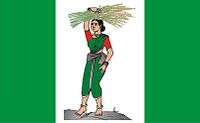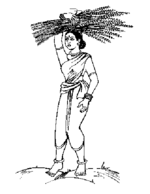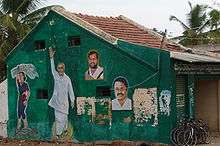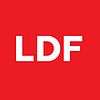Janata Dal (Secular)
The Janata Dal (Secular) is an Indian political party[3] led by former prime minister of India, H. D. Deve Gowda. The party is recognized as a State Party in the states of Karnataka, Kerala and Arunachal Pradesh. It was formed in July 1999 by the split of Janata Dal party.[4][5] It has a political presence mainly in Karnataka. In Kerala, the party is a part of the Left Democratic Front.
Janata Dal (Secular) | |
|---|---|
 | |
| Abbreviation | JD(S) |
| President | H. D. Deve Gowda |
| Lok Sabha leader | Prajwal Revanna |
| Rajya Sabha leader | H. D. Deve Gowda |
| Founder | H. D. Deve Gowda |
| Founded | July 1999 |
| Preceded by | Janata Dal |
| Headquarters | JP Bhavan, 19/1, Platform Road, Seshadripuram, Bengaluru, Karnataka-560020 |
| Student wing | Student Janata Dal |
| Youth wing | Yuva Janata Dal |
| Women's wing | Mahila Janata Dal |
| Labour wing | Karmikara Janata Dal |
| Ideology | Secularism[1] |
| Colours | Green |
| ECI Status | State Party[2] |
| Alliance | UPA(Karnataka)
(2018 - 2019) LDF(Kerala) |
| Seats in Lok Sabha | 1 / 543
|
| Seats in Rajya Sabha | 1 / 245
|
| Seats in Karnataka Legislative Assembly | 34 / 224
|
| Seats in Kerala Legislative Assembly | 3 / 140
|
| Number of states and union territories in government | 1 / 31
|
| Election symbol | |
 | |
| Website | |
| jds | |
History

The Janata Dal(Secular),formed in 1999, had its origins in the Janata Party,founded in 1977 as a coalition of several smaller parties that combined forces to oppose the Indian National Congress.[6] In 1988 the Janata Party and other smaller parties merged to form the Janata Dal.[7][8][9] In 1996, Janata Dal reached its pinnacle when H. D. Deve Gowda became Prime Minister of India, heading the United Front (UF) coalition government.[10][11]
The Janata Dal split in 1999, when a faction led by Chief Minister J. H. Patel lent support to the Bharatiya Janata Party-led National Democratic Alliance leading to the formation of Janata Dal(Secular) under H. D. Deve Gowda and Siddaramaiah. The Sharad Yadav faction of the Janata Dal, the Lok Shakti and the Samata Party merged as the Janata Dal (United).[12][13] Even though the premise for the split was its opposition to allying with the National Democratic Alliance, H. D. Deve Gowda stayed equally away from the Indian National Congress from the outset.[14]
JD(S) in Karnataka state for a time governed in a coalition with the Indian National Congress (INC) party, the first coalition government in Karnataka. There was much controversy over the JD(S) allying with the INC in Bangalore as the INC formerly had an outright majority and was diminished to second place with the BJP having a plurality. However, the JD(S) considered INC to be the lesser of the two evils on account of its erstwhile secular and center-left credentials.
The 2004 Karnataka Assembly election witnessed the revival of the party's fortunes with JD(S) becoming part of the ruling coalition in the state.
On 14 April 2015, the JD(S), Janata Dal (United), Rashtriya Janata Dal, the Indian National Lok Dal, Samajwadi Party, and Samajwadi Janata Party (Rashtriya) announced that they would merge into a new national Janata Parivar alliance in order to oppose the BJP, thus leaving the UPA.[15]
Prominent members
- H. D. Deve Gowda, President of Janata Dal (Secular), former prime minister of India and former chief minister of Karnataka.
- H. D. Kumaraswamy, former chief minister of Karnataka, son of former prime minister of India H. D. Deve Gowda and former Karnataka State president of Janata Dal (Secular).
- Nikhil Gowda, state president, Yuva Janata Dal (Secular).
- Prajwal Revanna, MP of Hassan, Lok Sabha leader of Janata Dal (Secular).
- Basavaraj Horatti, former chairman of Karnataka Legislative Council, and former cabinet minister of Karnataka
- B. M. Farooq, current MLC of Karnataka Legislative Council, current national general secretary Of Janata Dal (Secular).
- C. S. Puttaraju, former minister for small irrigation resources, and former Member of parliament, Lok Sabha from Mandya.
- GT Devegowda, former minister for higher education, and MLA from Chamundeshwari (Vidhana Sabha constituency).
- Sarekoppa Bangarappa, former Chief Minister of Karnataka.[16]
- N. M. Joseph, vice president of Janata Dal (Secular).
- H. D. Revanna, former cabinet minister, present MLA, Karnataka (Son of H. D. Deve Gowda).
- D. Kupendra Reddy, MP of Rajya Sabha[17][18]
- Mathew T. Thomas, former Kerala State president of Janata Dal (Secular) and former Kerala State minister.
- Madhu Bangarappa, former MLA of Karnataka Legislative Assembly.
- Jose Thettayil, vice president of Janata Dal (Secular), former minister Govt. of Kerala.
- C. K. Nanu, state president of JD(S) Kerala, former minister Govt. of Kerala and MLA.
- Neelalohithadasan Nadar, former Kerala State president of Janata Dal (Secular) (former minister Govt. of Kerala; former member of Parliament, Govt. of India).
- Mohamed Zafrulla Khan, national general secretary, former chairman KMDC
- K. Krishnankutty, current Kerala State minister for water resources.
- Gegong Apang, former Chief Minister of Arunachal Pradesh
- Tanveer Ahmed, national spokesperson, Janata Dal (Secular).
List of chief ministers
Chief ministers of Karnataka
| No | Name | Constituency | Term of office | Tenure length | Assembly | |
|---|---|---|---|---|---|---|
| 1 | H. D. Kumaraswamy | Ramanagaram | 3 February 2006 | 8 October 2007 | 1 year, 247 days | 12th |
| H. D. Kumaraswamy | Channapatna | 23 May 2018 | 23 July 2019 | 1 year, 92 days | 15th | |
Deputy chief ministers of Karnataka
| No | Name | Constituency | Term of office | Tenure length | Assembly | |
|---|---|---|---|---|---|---|
| 1 | Siddaramaiah | Chamundeshwari | 28 May 2004 | 5 Aug 2005 | 1 year, 69 days | 12th |
| 2 | M. P. Prakash | Hadagali | 5 Aug 2005 | 28 January 2006 | 176 days | 12th |
Assembly election history in Karnataka
| Year | Assembly election | Seats contested | Seats won | Votes secured | Percentage of votes |
|---|---|---|---|---|---|
| 1999 | 11th Assembly | 203 | 10 | 23,16,885 | 10.42%[19] |
| 2004 | 12th Assembly | 220 | 59 | 52,20,121 | 20.77%[20] |
| 2008 | 13th Assembly | 219 | 28 | 49,59,252 | 18.96%[21] |
| 2013 | 14th Assembly | 222 | 40 | 63,29,864 | 20.09% |
| 2018 | 15th Assembly | 202 | 37 | 66,66,307 | 18.30% |
Lok Sabha election history in Karnataka
| Year | Lok Sabha election | Seats contested | Seats won | Votes secured | Percentage of votes |
|---|---|---|---|---|---|
| 2004 | 14th Lok Sabha | 28 | 2 | 51,35,205 | 20.45%[22] |
| 2009 | 15th Lok Sabha | 21 | 3 | 33,35,530 | 13.58% |
| 2014 | 16th Lok Sabha | 25 | 2 | 34,06,465 | 11.00%[23] |
| 2019 | 17th Lok Sabha | 8 | 1 | 33,97,229 | 9.67% |
See also
References
- "Official website ideology section". Jds.ind.in. 26 October 2014. Retrieved 12 March 2017.
- "List of Political Parties and Election Symbols main Notification Dated 18.01.2013" (PDF). India: Election Commission of India. 2013. Retrieved 9 May 2013.
- "History of Janata Dal (Secular) according to its website". Retrieved 30 September 2007.
- "EC to hear Janata Dal symbol dispute". Archived from the original on 1 February 2009. Retrieved 30 September 2007.
- "The Nation:Janata Dal:Divided Gains (India Today article)". Archived from the original on 9 January 2016. Retrieved 30 September 2007.
- "britannica.com : Janata Dal (Secular)".
- "article on Chandrashekar". Retrieved 30 September 2007.
- "Bouquet of ideologies - article in the Hindu". Retrieved 30 September 2007.
- "Janata Dal". Retrieved 30 September 2007.
- "Profile of Deve Gowda on PMO website". Archived from the original on 10 October 2007. Retrieved 30 September 2007.
- History « Welcome to Janata Dal (Secular) Official Website. Jds.ind.in. Retrieved on 2014-05-21.
- "Janata.in". www.janata.in.
- Archived 3 January 2008 at the Wayback Machine
- ""Gowda rules out tieup with Congress " - Tribune India article". Retrieved 30 September 2007.
- "'Janata Parivar' formalised, Mulayam Singh named chief of new party | Zee News". Zeenews.india.com. 15 April 2015. Retrieved 12 March 2017.
- D A I J I W O R L D. D A I J I W O R L D (2011-08-10). Retrieved on 2014-05-21.
- "Kupendra Reddy files papers as JD(S) candidate for RS polls". The Hindu. Special Correspondent. 8 June 2014. ISSN 0971-751X. Retrieved 23 February 2019.CS1 maint: others (link)
- "D. Kupendra Reddy". PRSIndia. 25 October 2016. Retrieved 23 February 2019.
- "Archived copy" (PDF). Archived from the original (PDF) on 11 January 2012. Retrieved 25 October 2011.CS1 maint: archived copy as title (link)
- List Of Political Parties. (PDF) . Retrieved on 2014-05-21.
- "Archived copy" (PDF). Archived from the original (PDF) on 3 March 2014. Retrieved 17 July 2012.CS1 maint: archived copy as title (link)
- "Archived copy" (PDF). Archived from the original (PDF) on 18 July 2014. Retrieved 25 October 2011.CS1 maint: archived copy as title (link)
- "Partywise Trends & Result". 21 May 2014. Archived from the original on 21 May 2014.
